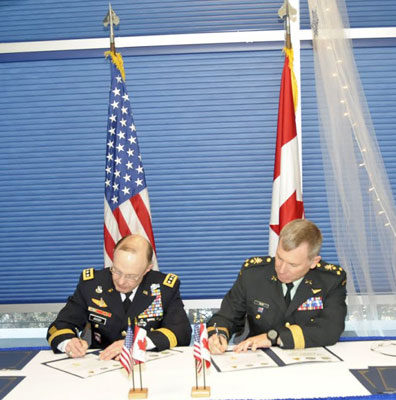|
December 30, 2012
The Arctic has become an important part of North American perimeter security.
Recently, the U.S. and Canada signed two new
agreements that will expand bilateral military training, security and
defense operations in the region. Both countries are working together to
prepare for any real or perceived threats and are moving towards merging
their Arctic foreign policies.
According to a press release, the framework is designed to,
USNORTHCOM, CJOC and NORAD will work more closely in the region with regards to planning, domain awareness, information-sharing, training and exercises, operations, capability development, as well as in the area of science and technology.
This also ties in with the Tri-Command Training and Exercise Statement of Intent.
The newly signed military document is aimed at,
The latest U.S.-Canada military agreements are part of the Tri-Command strategy and demonstrate the importance being placed on the Arctic.
The Tri-Command Vision has previously called for USNORTHCOM, NORAD and Canada Command which has now been replaced by CJOC to,
In order to better achieve these objectives,
The Tri-Command is part of efforts to merge both
countries, security and military priorities under the umbrella of a single,
U.S.-dominated North American Command.
With the move, USNORTHCOM was given the primary task of planning and advocating for future Arctic capabilities, as well as engaging with stakeholders across the U.S. military, other agencies and international bodies.
This is significant considering USNORTHCOM’s partnership with CJOC, along with NORAD and was instrumental in the development of the Tri-Command Framework for Arctic Cooperation.
In an example of what we can expect with regards to joint Arctic security, Canada’s 2010 military sovereignty exercise, Operation Nanook included the U.S. and Denmark.
The Arctic is also an emerging issue for the
NATO alliance. Canada and the U.S., along with other NATO member countries
have participated in the annual
Cold Response war games. Strengthening its military presence in the
region and enhancing security collaboration with Canada and other northern
partners has become an essential component of America’s Arctic strategy.
The intergovernmental forum which also includes,
...promotes cooperation, coordination and interaction among the Arctic states.
The Arctic Council has signed an Agreement on Cooperation in Aeronautical and Maritime Search and Rescue which became the first legally binding deal ever negotiated between all the eight Arctic nations.
As far as military and security concerns go, in April 2012, Canada hosted a meeting of the Northern Chiefs of Defence to discuss shared Arctic interests. This included common safety and security issues in the region such as emergency response and support to civilian authorities.
The conference provided a setting to hold
multilateral and bilateral talks focused on the Arctic and there are calls
to have similar meetings on a regular basis.
At times, Canadian and Russian rhetoric in regards to Arctic sovereignty has been reminiscent of the Cold War era. Rising tensions could further escalate the militarization of the far north. Increasing diplomatic efforts is the key to building the foundation for more multilateral cooperation in the area.
While the process to resolve territorial disputes and the scramble to secure resources has thus far been peaceful, the Arctic still remains a potential flashpoint for conflict.
|

